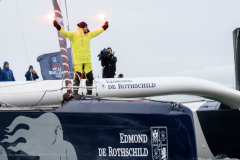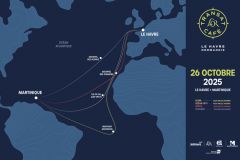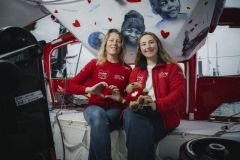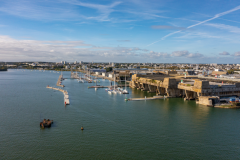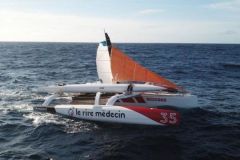You've been sailing together for a long time, can you tell us about it?
OLIVIER KRAUSS: The first time was 25 years ago! I think we're the oldest couple in the fleet. We raced as a crew at first, then we went on to double up.
THIERRY BOUCHARD: We've changed from time to time, but we've always come back together. We're very different, so we complement each other well. We've shared some great moments on tours de France or on deckchairs. Now we don't ask ourselves any more questions, it's natural. Even if one of us gets a bit pissed off, it's not a big deal, we know it'll pass. That's what's nice, there's no competition between us. We're happy to be here, to share the same passion and we're each doing our best to get the boat going.
How is your life on board organized? Since all this time have roles been set up?
THIERRY BOUCHARD: We're organized.
OLIVE KRAUSS: ...pretty much.
THIERRY BOUCHARD: Let's just say in our mess, we're organized.
OLIVIER KRAUSS: I've always been a bit more concerned about the weather and strategy before and during the race. Even if for this race we have a navigator, it's always me who has him on the phone. That's the part I manage a little bit, even if of course we discuss it together. I make the first approach.
About how the boat works, we don't even have to talk anymore. If one is tired, the other will help. It's hard to explain because it's become so natural.
THIERRY BOUCHARD: The goal is to be available for the boat. We have the same state of mind on that. We have to share things, one of us has to rest while the other one manages the boat. Except for the manoeuvres that we have to do twice. It's faster, it's much safer. Especially in the first few days which are going to be physical.
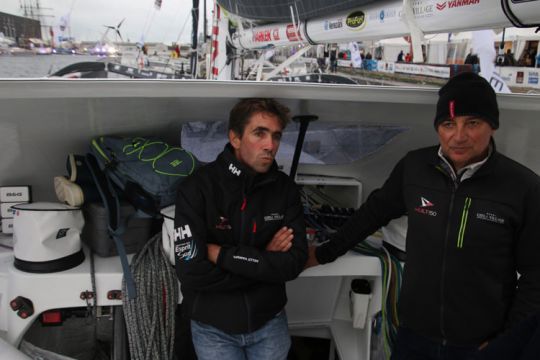
What led to the launch of the new boat project?
THIERRY BOUCHARD : We had succeeded in a good operation by buying back Maitre Jacques and retyping him. We made two good scores with it. Two times second: the Jacques Vabre and the Québec-Saint Malo. Since then, the Multi 50 class has allowed foils on the boats, which was not planned for 2015 when we entered this class. We had two choices: either add foils like the others or start from scratch and build a boat around the foils. We had the ability to do it, so we did it! The technical adventure is also part of the sporting adventure. It's really nice to be able to take part in building the boat. It's really nice to be able to think about the choices beforehand and to know why we did this or that thing. When we buy a second-hand boat, we're handed over to us. They give us the key and we have to adapt.
We were able to do it our way and the way we wanted to.
Since the launch on October 4, what have you been able to get back from your sailing? Is the boat ready?
OLIVIER KRAUSS: That's what we expected. We're feeling good. We're confident, the boat looks healthy, well-born. But we haven't yet sailed in a lot of sea and strong wind with this boat, we don't yet know how to adjust the foils. We'll discover these adjustments during the race.
THIERRY BOUCHARD: The boat is ready, there's no doubt about it. We have confidence in the boat, we're leaving with confidence.
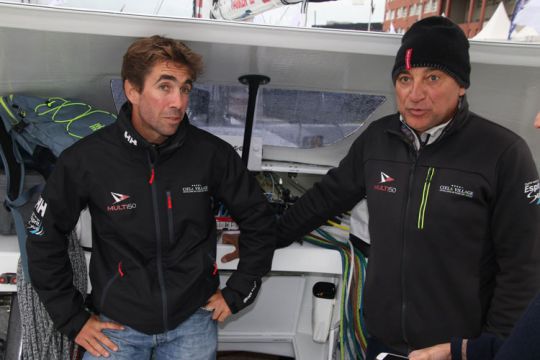
Sailing with foils has changed your way of sailing a lot?
OLIVIER KRAUSS: It's still sailing. You have to tuck, shock, trim, but there are extra foils adjustments. The foils adjustment is linked to the daggerboard adjustment, if you set up the daggerboard, how much rake do you need to put on? We've had a little help, we've got some information on a board, but it has to be adjusted on the water.
Can you introduce us to this new boat?
THIERRY BOUCHARD: We have C-shaped foils, these are one-design foils supplied by the Multi 50 class so that there is equity between each boat. They are adapted to all boats. It's an agreement between all the architects who designed the current Multi 50s which has made it possible to achieve this shape.
Once the foil is deployed, from a certain speed it allows the boat to be lifted. It can be adjusted like an airplane wing to go up or down - this is called rake. Except that instead of leaning on the air, you lean on the water. Since our boat is new, we were able to install the foil at the most appropriate balance point. The foil is very advanced. On older boats, the connecting arm prevents the foil from moving forward. So they have a more backward foil, which will make it more difficult to steer the boat. On Ciela Village, the position of the foil determined the position of the arm. These are X arms, which allow the centre of gravity of the boat to be moved backwards. Compared to our old boat, the mast is one metre further back.
The first sensations are great, it's a real treat. We were able to validate the boat's balance and the feeling of speed and safety from the very first sail, as we no longer have the fear of going into the water that we had before. We're above the waves and it's a lot more fun.
We have more volume at the back of the floats, as we only have foils at the front of the boat, so depending on the rake - that is to say, the incidence you put on the foil - the boat will pitch up. You don't want it to sink into the water, hence the wider choice of float.
We've also been working with the archers on the aerodynamics of the boat to limit drag. We built a cap that covers the entire cockpit and all the manoeuvres are performed by a piano, which is sheltered by this cap. We also have a tunnel between the mast and the cap which allows us to hide all the ends, so there is nothing lying around. We've also refocused the helm stations because a helm station, its protection, its winch, a lot of ends, a lot of listening ... These are all brakes. When you know that you can reach speeds of 40 knots, the more you are hidden, the more speed you can gain, like a motorbike fairing.
Refocusing everything will also be safer and more comfortable. There are no more adjustments to be made downwind, which are quite complicated and sometimes risky when there are seas.
Further developments will come next year to further improve the drag. But already there it is a big step forward compared to the older boats.
The passenger compartment is centred under the helm station, again to move the centre of gravity back. The difficulty is that accessibility is tricky. You have to sleep well, but when you sleep, it's a bit complicated to get out. Double that will do it. In solo it will be more complicated. We'll do a debrief at the end of this deckchair to see how we'll do it.
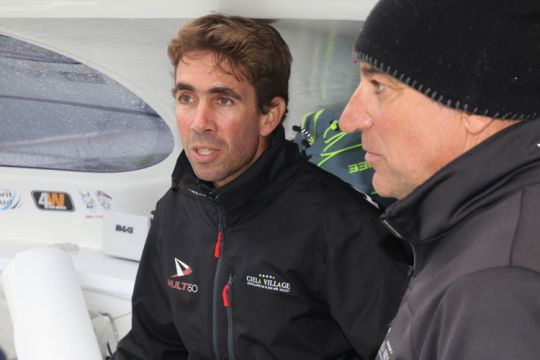
Under what conditions will the boat be most comfortable?
OLIVE KRAUSS: As soon as we can get the foils on. From 14-15 knots of wind depending on the sea. The boat relieves itself and takes 2-3 knots more than a boat without a foil. For the points of sail, the boat is at ease as soon as you pull the helm a little.
At the start we will have the sea, a small lull in Ushant and again a front to pass with even more sea. It's going to last 3 days, so for 3 days we'll have to be careful. These boats are not adapted for that. You have to know how to measure out, slow down when necessary and then attack again.
But even if we're careful, the foils are going to make us a lot of money. From Cherbourg to Ushant, we've got nothing but trouble. The routing gives us 30-32 knots with 25 knots of wind, which is exactly the point of sail where the boat goes the fastest. Between 100° and 110° of true wind, the boat can crash or heel, so it's better to have a small sail in front, we have to be careful. It's not very long, but we're in a regatta, so if the friends are going 5 knots faster, we'll put the canvas back on ... you have to dose it.





